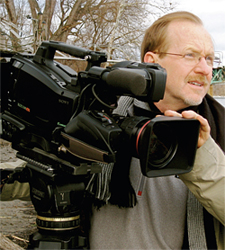Angenieux Lens Makes HD Sparkle

Jerome Noonan
LONGMEADOW, MASS.
I recently made the move into tapeless acquisition, migrating from a standard-definition Sony camera with Beta and DVCAM backs to a new 2/3-inch tape-less HD camera. I've used an Angenieux 15x8.3 AIF lens since 1998 and have been very happy with it. There were never any service problems, and it provided me with an exceptional degree of control over my images, giving precise focus and the ability to achieve a "film-like" narrow depth of field when I needed it.
When it came time to select a lens for this new, higher-resolution camera, I returned to Angenieux and selected their 19x7.3 BSMD-E HD model. I had 12 good years from my first Angenieux lens and desired the same caliber of optics for this more critical high-definition video standard.
LENSES JUST KEEP GETTING BETTER
Actually, I took possession of my new HD camera before I had a chance to order a lens and toyed with the idea of saving the investment in optics by using the old glass. The imaging looked darn good, until I compared it with that produced by the new lens. The improved HD lens offered much more detail, along with a lot less chromatic aberration. In short, it provides me with more precision. I also needed more from the wide-end of the lens in this 16:9 world, so it wasn't diffi-cult to make the decision that HD image capture really deserved an HD lens.
Now that I've had it out a few times, I'm further impressed with the lens's focal range. It can provide a limited depth-of-field at the medium-close distances frequently used for interview settings. With the iris opened up, a nice look can be achieved even at eight feet from the subject, with the background being dropped out of focus. The lens's zoom rocker has an intuitive feel to it and engages gently and increases in speed transparently. The digital functions allow ad-justment of the "zoom laws," but I've found that the default setting was very responsive.
MANY NEW USEFUL FEATURES
Other digital functions have proven handy as well. These include the "zoom position preset," which allows an exact focal length to be pre-set and quickly re-turned to. This is useful for nailing the tight-shot framing in your basic two-focal-length interview, or for returning to the exact same focal length at the start of a zoom-out.
The lens also has a "zoom limitation setting," which provides programmable presets for either or both ends of a zoom. The ends of the zooms are also nicely damped. One function that I'd not experienced previously was "auto-cruise." With it, a very slow zoom speed can be held for the length of the move—hands free. This is a very nice feature.
The macro focus provides both an extremely close minimum object distance and a fairly wide range of focal lengths where it's operative. This is another in-stance where limited depth of field can be achieved for enhanced background separation.
I'm looking forward to mastering all that this lens has to offer, and I'm confident that I'll get just as many years of service from it as I did my other Angenieux.
Jerome Noonan has been shooting high-end video for broadcast and corporate clients for more than 20 years. He may be contacted atmail@jeromenoonan.com
For additional information, contact Angenieux at 973-812-3858 or visitwww.angenieux.com.
Get the TV Tech Newsletter
The professional video industry's #1 source for news, trends and product and tech information. Sign up below.
